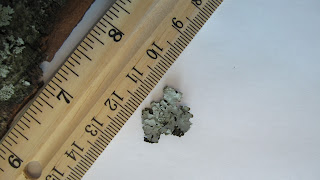Course Description from the Hiram College Catalog: Classification, identification,
ecology, evolution, and comparative morphology of non-vascular plants, including algae, fungi, lichens and bryophytes. Emphasis is on the evolutionary development in complexity of
structure and of reproductive patterns. Current concepts of kingdoms of organisms
are also covered. Field work includes identification of bryophytes, fungi, lichens,
slime molds, and algae . Individual projects combine basic ecological principles with
the study of the local flora. Prerequisites: Biology 151, 152, or permission. The breakdown
between lecture and lab hours is for administrative office use only. This course may only
be taken as 4 credit hours.
Location/Time: Lecture: Gerstacker 221 MWF 8:30-9:50
Lab: Gerstacker 221 Thursday 1:00-4:00
Course Objectives: Nonvascular "plants" are those organisms traditionally studied by botanists because they didn't move about like animals and that lack vascular tissue (xylem and phloem). This is a tremendously diverse assemblage of organisms. In fact, some of these organisms are more closely related to animals than to our familiar, and very large, vascular land plants. This course is an introduction to all those organisms. They are extremely important, if often overlooked, because they play vital roles on earth.
Thus, the objectives of the course are to:
1. Examine the historical context, both evolutionary and human, of the discovery and understanding of these organisms.
2. Become proficient in identifying as many of these organisms as possible at the J.H. Barrow Field Station and surrounding areas.
3. Learn sufficient terminology and skill to use keys to identify unknown algae, fungi, lichens, slime molds, mosses and liverworts.
4. Create a Non-Vascular Collection Blog containing pictures of your specimens that you collect, ecological and collection data, keying data, and identification information as well as a preserved set of herbarium specimens.
5. Find, read, understand, interpret and apply the primary literature as you prepare an essay on Classification.
6. By the end of the the term, you should know how to identify Non-Vascular Plants, be able to explain their life cycles, as well as their niches in the biosphere, and how they are related to other organisms.
Texts: Stephenson, S.L. 2010. The Kingdom Fungi The Biology of Mushrooms, Molds, and Lichens. Timber Press, Inc. Portland, Or.
Kimmerer, R.W. 2003. Gathering Moss A Natural and Cultural History of Moss. Oregon State University Press. Coravalis, Or.
Other Materials Needed: A digital camera, field notebook, pocket knife, backpack or bag, pencils, plant keys for your chosen organism group
Assessment: Quizzes, Homework assignments, 3 Exams, Final Cumulative Exam, Non-Vascular Organisms Collection & Blog, Classification Essay, Participation/Attendance






